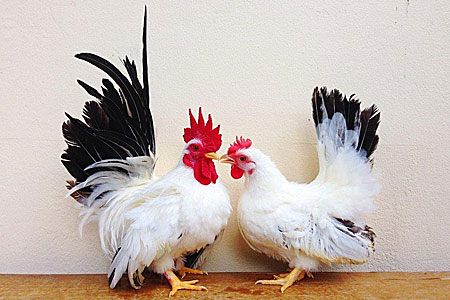
Japanese bantams bred for exhibition must have short legs, according to the Standard of Perfection. Unfortunately this trait comes with a dominant lethal gene called creeper (Cp). The creeper gene causes embryos to die during incubation, resulting in a reduced hatch rate for Japanese bantam eggs. Here’s how the lethal creeper gene works:
Creeper Genetics
Pairs of genes, one from each parent, control genetic traits. Variations in the genes for a particular trait are called alleles. When both alleles are the same, the offspring is homozygous. When the two paired alleles differ, the offspring is heterozygous. In heterozygous offspring, a dominant allele prevails over a recessive allele.
Japanese bantams with short legs are heterozygous, meaning they inherit one dominant Cp allele and one recessive allele for normal leg length. Cp causes the long bones in the legs to grow to only about 80% of their normal length. But any bird that inherits two Cp alleles, or is homozygous for Cp, dies in the embryo stage, usually during the first week of incubation.
Breeding Japanese Bantams
Japanese bantams with short legs may be bred in one of two ways. They may be the offspring of two parents with short legs. Or one parent may have short legs and the other normal legs.
If both parents have short legs, approximately 50% of the chicks will be heterozygous and therefore will have short legs. Some 25% will be homozygous for normal leg length. Another 25% will be homozygous for Cp, and therefore will die during the early stages of incubation. Of the surviving offspring, then, about two-thirds will have short legs and one-third will have normal legs.
| Cp | Normal | |
| Cp | Lethal (25%) | Short (25%) |
| N | Short (25%) | Normal (25% |
Both parents are heterozygous.
If one parent has short legs and the other has normal legs, about 50% of the offspring will be homozygous for normal legs. Nearly 50% will be heterozygous and therefore have short legs. None will be homozygous for lethal Cp.
| Normal | Normal | |
| Cp | Short (25% | Short (25%) |
| N | Normal (25% | Normal (25%) |
One parent is heterozygous, the other is homozygous for normal legs.
Regardless of whether both parents have short legs, or only one does, about 5% of the heterozygous eggs will die during the last days of incubation. So even a single Cp allele results in some loss of hatchability.
Normal (Long) Legs
If both parents have normal (long) legs, neither parent has the creeper gene. All the offspring therefore will have legs of normal length.
The only thing “wrong” with Japanese bantams that lack the creeper gene, and therefore have legs of normal length, is that they aren’t suitable for exhibition. But they still make pretty backyard chickens and nice pets.
And that’s today’s news from the Cackle Coop.
Gail Damerow is the author of Hatching and Brooding Your Own Chicks: Chickens, Turkeys, Ducks, Geese, Guinea Fowl.

